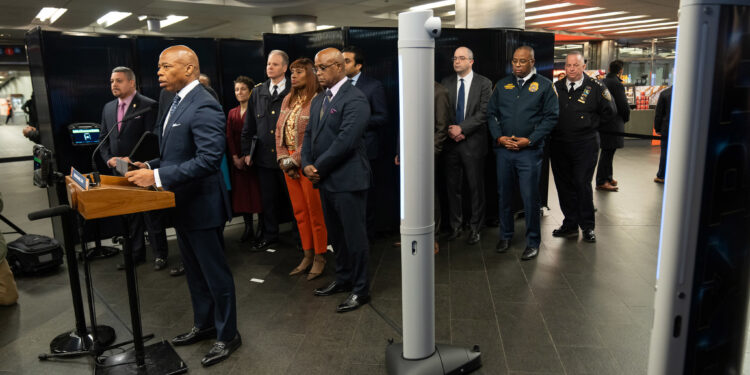On Wednesday, July 24th, Mayor Eric Adams announced that New York City would soon begin a pilot program deploying gun detection technology in several subway stations. This initiative, spearheaded by the Massachusetts-based company Evolv, aims to enhance public safety by using artificial intelligence to detect concealed firearms. The technology, similar to traditional metal detectors but equipped with advanced sensors, is set to be installed following a 90-day waiting period required under city regulations for new surveillance tools.
Evolv’s system, already in use at various venues like sports stadiums, promises a more efficient and less intrusive method for detecting weapons. Mayor Adams expressed optimism about the potential benefits, stating, “This technology represents a significant step forward in ensuring the safety of our transit system.” The pilot program will Initially cover a limited number of stations, though specific locations have yet to be disclosed.
Despite the potential advantages, the deployment of this technology has been subject to controversy. Critics, including the Legal Aid Society, argue that the system could lead to privacy violations and false positives, potentially causing unnecessary panic. Jerome Greco, an attorney with the Legal Aid Society, commented, “Simply put, gun detection systems are flawed and frequently trigger false alarms, which induces panic and creates situations that could result in the loss of life.” This concern is compounded by Evolv’s ongoing legal challenges, including a class-action lawsuit alleging misrepresentation of the technology’s capabilities.
The introduction of Evolv’s scanners comes amid a broader debate about the balance between public safety and individual privacy rights. While some New Yorkers welcome the increased security, others are wary of the potential for misuse and the implications for civil liberties. The city plans to monitor the pilot program closely, collecting data on the technology’s effectiveness and gathering public feedback to inform future decisions.
The rollout of gun detection technology in New York City’s subway stations marks a significant development in the city’s approach to public safety. As the program progresses, its impact on daily commuters and the overall security landscape will be closely watched by both supporters and critics. The results of this pilot program could shape the future of security measures in urban transit systems nationwide.










